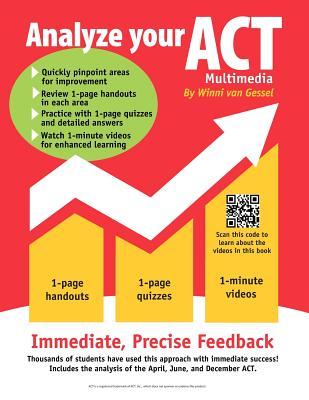This book revolutionizes the way students take the ACT. Before, they would study hundreds of pages with information about the ACT content and then take numerous tests. Neither approach gave them feedback about their mistakes and too often students would sigh, "I have a 29 .... again!"
With Analyze Your ACT, students FIRST get detailed feedback about exactly where they make mistakes. THEN, they study only those areas that hold back their score. All the needed material is presented in 1-page handouts, which are followed by 1-page practice drills and quizzes to gain mastery. For the visual learners, each chapter is enhanced with 1-minute videos that quickly explain the key concepts.
Motivation is key! Students do not want to waste an hour on punctuation rules, but they gladly study commas and semicolons if they know it will make a three-point difference in their ACT score. Most students need a quick review of geometry, but they do not need the theorems and postulates. Many students know they have forgotten the distance formula and the midpoint formula, and the only thing they need is a quick reminder about the fundamentals. The 1-page approach of this book helps to break the ACT down into bite-size chunks.
What does the ACT measure? The trendsheets in this book give an immediate overview of what the ACT is all about. And because the ACT is a standardized test, this pattern will repeat for every test in the past and the future. With this book, for the first time, students know what to study and how to improve, parents are able to provide guidance, and teachers can identify what materials to integrate into their curriculum.
Analyze your ACT explains math and English principles in simple language, yet goes into more depth than any other book in this field. The book combines facts and formulas with study skills and insights into complex questions. More than 200 tips are scattered throughout the book, and each one can make a difference in one or more ACT questions. The book even provides insights into particular ACT traps that have stopped top students from getting a perfect score.
The author, Winni van Gessel, studied Instructional Design at the University of Kentucky, and this background becomes apparent in the way the book approaches the test. The test itself is not the central part of this self-study book; the skills to ace the test are the driving force in each of its chapters. Mastering these skills will not only help students with the ACT, but also in other academic areas. The test-taking skills in this book are the key in the reading and the science parts of the ACT. Just like the composite score of the test is a combination of the four test, so is the approach to master this test a combination between knowledge and test-taking skills.
